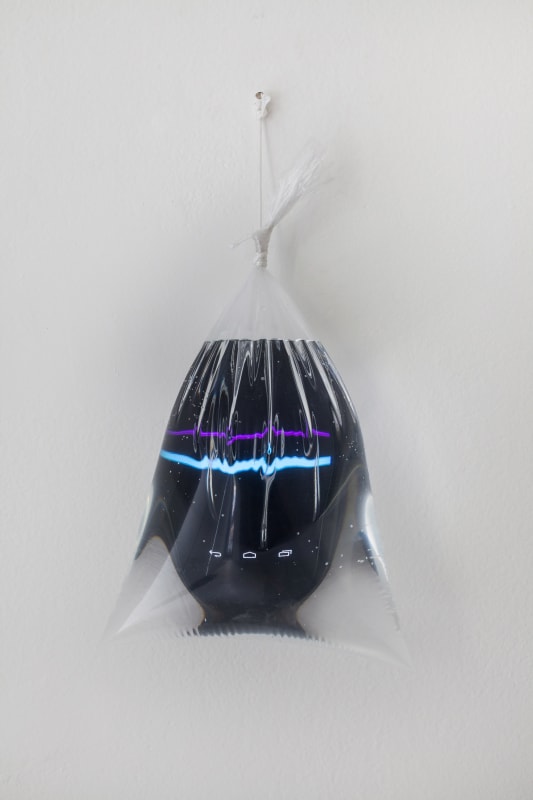"Instead of causing us to remember the past like the old monuments, the new monuments seem to cause us to forget the future. […] They are involved in a systematic reduction of time down to fractions of seconds, rather than in representing the long spaces of centuries. Both past and future are placed into an objective present." (Robert Smithson, "Entropy And The New Monuments", 1966)
A block of concrete vertically rests on a TV set while a chart created by digital processes is transmitted on the monitor. The image sometimes splits the screen in two in different shades of blue, and sometimes in different shades of grey. The shape of the block is also present and can be seen on TV like a shadow that moves according to the sun - now and again in perpendicular positions, and from time to time in a twofold space over itself.
When the vibrant blues take over the screen, it is hard not to associate that image with a familiar landscape in Brazilian architecture - Brasília's monumental axis under the immense horizon sky. In this case, there is an inverted monumentality - not only due to the block that seems to have been placed on the sky. The inversion occurs especially because of the difficulty in envisioning a durable aspect in that image, a basic concept for a monument or an architecture that performs as such. Its basis, unlike the solidity of concrete, carries the inherent obsolescence risk of any kind of technological device. And the future, as Smithson defines it, seems to only exist in the few seconds that the chart is displayed in a loop, like in an eternal and objective present.
The tension derived from the ambivalence between concrete's materiality and the immateriality of the digital images that appear in Transition (2017), is one of the central aspects in Felipe Seixas' exhibition. If in his previous works the blocks molded by the artist appeared in combinations with charcoal and pigments, exploring the relation between the objects' shape and non-shape, his recent production introduces a deeply contemporary discussion regarding the immaterial aspect of the new technologies that are already born under the imminent risk of becoming obsolete in a more than near future.
Thus issue also arises in Fall (2017), another piece in which he uses objects made of concrete in relation with digital charts. This time, four blocks are placed horizontally and serve as backing for a monitor that is installed on the pieces in a 45-degree angle. The screen displays an image with shapes that are identic to the objects, in various colors, in a chart created from the number of pixels referring to the resolution of a full HD TV. Matters such as the fragility of technological memory and their dematerialization are also present in Ascendency (2017), a work created by placing a cellphone behind a plastic bag filled with water. Seen only from a lateral point of view, the device is the medium for another chart that shows constantly moving colored lines, creating an optical distortion from the liquid refraction.
Even though technology has gained an important role in this exhibition, raising a possible association with the digital art field, Felipe's production comes from different references. Initially, minimalist sculptures would be the most immediate association, especially considering his use of heavy industrial materials, such as concrete, as the main foundation of his works thus far. The formal confrontation that appears in his choice of materials with amorphous appearances, like the plastic bag with water or blackberry flour, finds precedent in movements like Anti-form, disseminated during the 1960s by artists like Robert Morris, or the concept of formless, reintroduced in the art domain in the 1990s, represented by artists like Smithson.
But maybe it is in the idea of the immaterial that resides the point of contact between these influences. If the transformation of the world into images - and its own immateriality - was one of the great issues raised in the debates concerning immersive and illusionist environments of Post-Minimalism, during the past few years the immaterial has become a central theme in the discussions about new medias. The so-called "database aesthetics", in which the interface configurations where information is stored have become the target of artistic investigations, reveal how these structures have gained importance in themselves, regardless of their physical counterparts. On the other hand, Felipe still emphasizes his interest in the materiality of mediums like concrete, whose presence couldn't be any more physical and palpable.
It is through this vocabulary that Felipe's works are developed. As if in an unplanned obsolescence, contradicting the term that names the short lifetime of technological mediums, he interferes in the devices in order to reveal new possibilities for processes and temporalities. Material or immaterial, the artist's objects seem to bring back an interest in the concrete present, pulling away from an archivist obsession with the past or with a dystopian future.
Nathalia Lavigne

